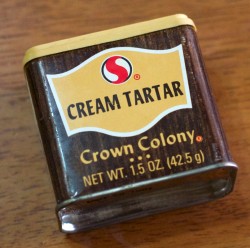Snopes takes on Cream of Tartar for Migraine
It’s not often that a Snopes article makes the rounds that is specifically focused on a migraine remedy, but the popular anti-myth site got some attention last month with a discussion of cream of tartar as a migraine remedy.
 Admittedly, the article is bound to offend a wide crowd, discussing “the dubious malady of ‘MSG poisoning,'”, acid levels in the body, and even taking a jab at a popular health news site. But let’s take a look at the core issue – is cream of tartar a good migraine remedy?
Admittedly, the article is bound to offend a wide crowd, discussing “the dubious malady of ‘MSG poisoning,'”, acid levels in the body, and even taking a jab at a popular health news site. But let’s take a look at the core issue – is cream of tartar a good migraine remedy?
What is cream of tartar? You may be familiar with cream of tartar as the white powdery substance used in baking. Baking soda actually contains cream of tartar. By itself, it’s often used to improve the look of things you’re cooking – this isn’t a cooking blog, so for a few tips, check out Cream of Tartar: What It Is and How to Use It.
But what is it? Joe Schwarcz PhD explains:
[Cream of tartar] is a byproduct of winemaking and remains behind as a sediment after fermentation. In chemical terms, it is potassium hydrogen tartrate which is basically partially neutralized tartaric acid.
[Cream of Tartar]
In everyday terms, let’s say this – cream of tartar is a mild acid in dry powdery form.
A search engine exploration will confirm that this is a “recommended” natural remedy (although now the Snopes article is pretty popular). And perhaps the last line in the Snopes article is key: “If the anecdotal reports of cream of tartar’s efficacy against headaches are real, it apparently works via a different mechanism than the ones proposed on the websites suggesting it to be a remedy.”
So what would that mechanism be?
As you might have guessed, cream of tartar is very high in potassium (of course, since it’s potassium hydrogen tartrate!). Potassium is very important in the body, regulating hydration and blood pressure, for example. In fact, in her popular book Fighting the Migraine Epidemic, Angela A. Stanton PhD advocates a system of hydrating the body with a balance of potassium and salt to fight migraine attacks.
But hold on – it’s not that simple. Although a daily recommended amount of potassium is by no means agreed upon, here’s an example – 4700mg/day (see High Potassium Eating). Now, a teaspoon of cream of tarter will give you 495mg of potassium – over 10% of your daily amount, and not far off from a cup of milk.
But taking that much potassium in powder form – or in a supplement – can be dangerous, and even trigger headaches and other symptoms. Why? because it messes with blood pressure.
Incidentally, a quick browse of popular potassium supplements show typical doses of far less than what a single teaspoon of cream of tartar would contain.
In spite of the fact that she advocates paying attention to potassium to fight migraine, Dr. Stanton warns against taking a potassium supplement:
I often receive the question if potassium should/could be supplemented in a pill form. The answer is no, you should not. Potassium is a dangerous mineral if too much is consumed (hyperkalemia) and if too little is consumed (hypokalemia). In both cases, if dietary changes don’t improve the condition, hospitalization is necessary. The harm in taking potassium as a supplement comes from the fact that it all absorbs at once. … Taken as a supplement by a migraineur, who normally has low blood pressure, it can cause fainting, palpitations, and potential heart damage, and may cause seizures. You are also likely to end up with a migraine.
She footnotes this discussion with various studies and discussions of how potassium actually works in the body.
So here’s the short answer: If your potassium is so low that you need such a high instant infusion of potassium, you have problems much more serious than slightly low potassium levels. You need to get to a doctor.
On the other hand, yes, potassium is important for migraine patients – but it should be taken the normal way, in normal foods, such as milk, spinach, avocado, and salmon. That way, the potassium absorbs normally.
By the way, don’t worry about the small amounts of cream of tartar that you typically use in cooking and baking. We’re talking here about taking it directly as a supplement.
Although the Snopes article was specifically responding to a discussion of MSG, migraine, and cream of tartar, the bottom line still seems to be that there are great sources of potassium you can make use of right now – but a teaspoon of cream of tartar isn’t one of them.
